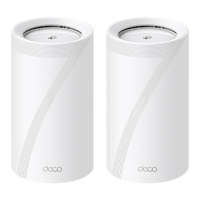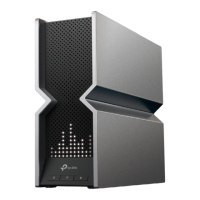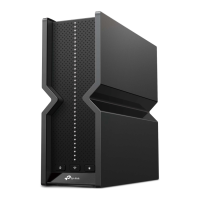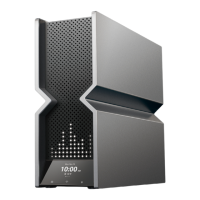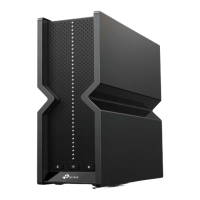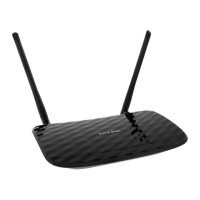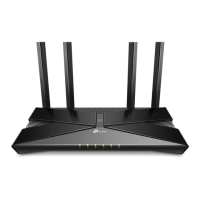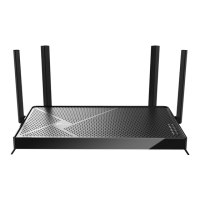
Do you have a question about the TP-Link BE230 and is the answer not in the manual?
| Wi-Fi Generation | Wi-Fi 7 |
|---|---|
| MU-MIMO | Yes |
| OFDMA | Yes |
| Beamforming | Yes |
| Wi-Fi Standard | IEEE 802.11be |
| Frequency Band | 2.4 GHz, 5 GHz |
| Maximum Speed | 23 Gbps |
| USB Ports | 1x USB 3.0 |
| Processor | Quad-core |
| Security | WPA3 |
| Operating Temperature | 0°C to 40°C |
| Storage Temperature | -40°C to 70°C |
| Humidity | 10% to 90% non-condensing |
Overview of the TP-Link dual band Wi-Fi 7 router and its features.
Details on the front and back panel components and LED indicators.
Guidelines for optimal router placement to ensure good signal and prevent hazards.
Step-by-step instructions for connecting the modem and powering on the router.
Guidance on using the wizard for router internet setup and TP-Link Cloud service.
Instructions for setting up the router using the TP-Link Tether mobile application.
Detailed steps to manually configure internet connection types like Dynamic IP, Static IP, PPPoE.
Configuring the router to function as an access point for an existing network.
Steps for configuring IPv6 connection types and setting up IPv6 firewall rules.
Instructions for creating and activating a TP-Link ID for router management.
Guide to updating the email address and password associated with your TP-Link ID.
Adding or removing other TP-Link IDs to manage the router, distinguishing Admin/User roles.
Using the Tether app on mobile devices to monitor and manage the router remotely.
Customizing SSIDs, passwords, security options, and advanced wireless features.
Setting a schedule to automatically turn the wireless network on or off.
Methods for connecting devices using Wi-Fi Protected Setup (WPS) via PIN or button.
Configuring advanced wireless parameters like WMM, AP Isolation, Airtime Fairness, Beacon Interval.
Steps to set up a separate Wi-Fi network for guests, including SSID and bandwidth control.
Configuring guest permissions, like allowing guests to see each other or access the local network.
Instructions for accessing USB devices locally on Windows/Mac and remotely via FTP.
Enabling Media Sharing to view photos, play music, and watch movies from USB via DLNA.
Configuring the router to back up files from a Mac to a USB storage device using Time Machine.
Scanning and analyzing the network for better performance and security.
Setting up unique restrictions on internet access for family members, including content filtering and time limits.
Prioritizing network traffic for specific devices to ensure smooth performance during heavy traffic.
Details on additional HomeShield features, including IoT Protection and Malicious Content Filter.
Steps to add another TP-Link router to create an EasyMesh network for extended coverage.
Instructions for adding a range extender to form a unified Wi-Fi network via EasyMesh.
Viewing and managing mesh devices and connected clients within the EasyMesh network.
Configuring the SPI Firewall to protect the router from unauthorized access and traffic validation.
Blocking or allowing specific devices to access the network using Deny or Allow lists.
Binding IP addresses to MAC addresses to prevent ARP spoofing and other ARP attacks.
Configuring Application Layer Gateway (ALG) settings for specific protocols like FTP and SIP.
Isolating IoT devices to protect the network from security threats and unauthorized access.
Setting up port forwarding to make local services accessible from the internet.
Configuring port triggering to dynamically open external ports for specific applications.
Configuring a PC as a DMZ host to bypass port restrictions and expose it to the internet.
Enabling UPnP to allow applications like online games to automatically open necessary ports.
Setting up an OpenVPN server on the router for secure remote access to the home network.
Configuring the router as a PPTP VPN server for remote access to the home network.
Setting up an L2TP/IPSec VPN server for secure remote access to the home network.
Configuring a WireGuard VPN server for fast and secure remote access to the home network.
Configuring the router as a VPN client to access remote VPN servers from the home network.
Modifying internet connection settings, MAC address, NAT, and port negotiation speed.
Adjusting the router's LAN IP address and subnet mask to avoid conflicts.
Combining multiple LAN ports to create a single high-bandwidth data path.
Managing network traffic to prevent packet loss caused by congestion by notifying peers to stop data.
Setting up the router to enable Internet/IPTV/Phone services, including IGMP configuration.
Configuring the DHCP server, IP address pool, and reserving IP addresses for specific devices.
Configuring DDNS to access the router remotely using a domain name instead of an IP address.
Manually configuring routing entries to forward data packets to specific destinations.
Instructions for updating router firmware via auto, online, or local methods.
Backing up current settings to a file and restoring them later, or resetting to factory defaults.
Changing the login password for the router's web management page.
Enabling and configuring password recovery options using email and SMTP server settings.
Limiting router access to specific devices on the LAN using MAC address-based authentication.
Controlling remote access authority to manage the router, allowing all or specific devices.
Saving system logs locally or sending them to a mailbox for troubleshooting and status monitoring.
Using diagnostic tools like Ping and Traceroute to test connectivity with hosts or servers.
Configuring the system time by obtaining it from the internet or computer, and setting the display language.
Enabling and configuring the scheduled reboot feature to clean cache and enhance performance.
Enabling Night Mode to specify a time period during which the router's LEDs will be turned off.
